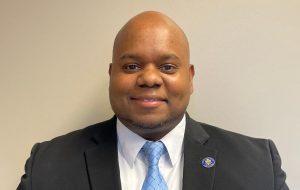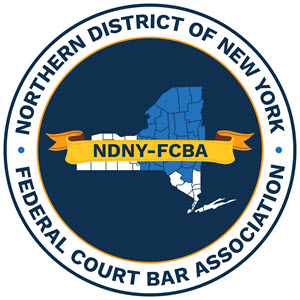 Maurice Christopher is the Director of Information Technology for the United States District Court and the United States Probation Office for the Northern District of New York. He began working for the Court in 2002, and now oversees a staff of nine people within the Clerk’s Office. Maurice and his team are responsible for maintaining and upgrading the technology across five courthouses. This includes supporting servers, network switches, and hundreds of other devices that connect to the Court’s network every day. Maurice, or “Mo,” discussed his background and enthusiasm for the job, the technology challenges and opportunities posed by the COVID-19 pandemic, and his passion for bowling.
Maurice Christopher is the Director of Information Technology for the United States District Court and the United States Probation Office for the Northern District of New York. He began working for the Court in 2002, and now oversees a staff of nine people within the Clerk’s Office. Maurice and his team are responsible for maintaining and upgrading the technology across five courthouses. This includes supporting servers, network switches, and hundreds of other devices that connect to the Court’s network every day. Maurice, or “Mo,” discussed his background and enthusiasm for the job, the technology challenges and opportunities posed by the COVID-19 pandemic, and his passion for bowling.
- First, tell us a bit about your background and how you got this job.
My journey in Information Technology started toward the end of my college career. In my last year of an undergraduate degree in biology I decided to take an introductory class for the Java programming language. At the time it seemed like an interesting elective to round out my final semester. This was my first computer science class and I was hooked from the very first day. I was drawn to the concept of multiple solutions to the same problem. I remember the feeling of creativity that came with solving programming problems with my unique knowledge and perspective. This class would end up changing the direction of my life. I decided to stay an extra year to complete a minor in computer science and I never looked back.
While completing that minor I landed an internship in the IT department of a law firm in New York City. My time there would reinforce my decision to pursue a career in technology. My first job was with the New York State Education department. This was a contract position through a small consulting firm that placed me in their tier one helpdesk call center. I was so new to the technology field that I was still typing with two fingers. I would use this time in the call center to develop my touch-typing skills and within a few short weeks I was typing sixty words a minute. Eight months into my time with the State Education department I received a call from the HR department of the Federal Court. I jumped at the opportunity to become a salaried employee for the court and the rest is, as they say, history.
- You’re well-known for being an easy-going, upbeat person who does great work, whereas IT workers are often (unfairly) stereotyped as cranky and unhelpful. What are the keys to your success?
I remember falling in love with computer science and realizing how powerful technology was in shaping my world. Since then, I’ve been on a mission to pass on my knowledge and show others how they can also benefit. Being personable and approachable has been my secret weapon. By engaging in casual conversations, I try to convey complex concepts in simple terms. I try to adapt to the skill level of my audience, and I’ve been very successful with this approach.
Early on in my career I learned that the foundation of my purpose was to help others do their jobs more efficiently. If I was good at my job, it means that others would be great at theirs. I was constantly receiving positive feedback from employees when I showed them something new. A quick example is showing someone how they can use the keyboard shortcuts Ctrl + C and Ctrl + V to copy and paste. I live for those “light bulb” moments where I can help improve someone’s productivity. Technology can be very overwhelming to many, but I’ve always felt that, if taken in small amounts, even the most technologically challenged individual can learn to embrace it.
Now ask my children that same question and they’d probably describe me as a grumpy IT dad.
- As is the case in many judicial districts around the country, many of the NDNY’s courtrooms were built in an era that predates modern courtroom technology. What is your approach in terms of retrofitting these courtrooms to make sure they are as well-equipped as possible?
When it comes to courtroom technology projects, my approach has always been to keep it simple. The saying “too much of a good thing” comes to mind. When starting the project, it is always tempting to add as much of the available technology as possible. I try to take a step back and outline all the “needs” verses all the “wants”. My team and I will look at the current tech and make sure the renovation provides the same minimum baseline of service. We’ll look to optimize where we can by using newer technologies. The goal is to make sure the new package of baseline services is better than they were in the past. Once we have all the “needs” established, we’ll then move on to filling in any gaps with the “wants.” This is where we can explore adding new features like fully integrated video conferencing systems. Having remote capabilities is high on the list these days so we try to make sure this functionality is addressed. At the end of the day, my main focus is making sure that the systems are easy to use for both court personnel and the bar. Throwing a ton of technology into a courtroom isn’t always a good idea if the parties in the courtroom have difficulty using it. By keeping things simple, the equipment is more widely used and is a benefit to the entire judicial process.
- From a courtroom technology perspective, what poses the biggest challenge and how have you tried to meet that challenge?
All the testing in the world won’t help when something stops working in the middle of a court proceeding. This one truth is why I believe all courtrooms have technology-related challenges. I meet these challenges by coming up with a backup plan. If I know a proceeding will have a remote video participant, I try to test the video equipment prior to the proceeding but I also try to come up with a backup plan. This could involve having a secondary video conference unit on standby or making sure there’s another courtroom that the proceeding could move to. I’m always looking for ways to provide redundancies for many aspects of the courtroom technology. These fail-safes are vital to keeping court proceedings on schedule. The one thing I’ve learned over my 20-year career is that things will go wrong, and always at the worst possible times. Having a backup plan helps put my mind at ease.
- The COVID-19 pandemic, now approaching its third year, placed additional and substantial burdens on your job. What were the biggest challenges?
One of the biggest challenges at the start of the pandemic was pivoting from an in-office work environment to an at-home work environment. We were not as prepared as I would have liked. I remember scrambling to find laptops and webcams for users. Like many companies around the world, we simply didn’t have enough hardware. Purchasing these devices was a nightmare because the demand was through the roof. We had to get creative by salvaging equipment from our disposal inventory. We were forced into reviving these older devices and giving them a new purpose.
Although we’re in a much better position today, the purchasing of computer equipment still poses a significant challenge. The microchip shortage and the global supply-chain problems continue to cause major delays for everyone. My approach is to buy equipment that will last five to seven years. We all need to have a long-term mindset because the pandemic has shown how unpredictable life can be.
- What are the best courtroom technology innovations to emerge from the pandemic that you hope will remain in place once the pandemic is over?
The most important courtroom technology to come out of the pandemic is video conferencing. Video conferencing has been around for quite some time. Most of the District Judge courtrooms have embedded video conferencing capabilities. Prior to the pandemic, these systems were used occasionally for unique situations. The use of this technology increased significantly during the pandemic. Allowing parties to appear remotely has been critical to the continuation of the administration of justice.
Like most companies around the world, the judiciary invested heavily in webcams, laptops with cameras, and video conferencing hardware/software. Software tools like Skype, Teams, and Zoom have forever changed the landscape of telework. We’ve all learned about and experienced the efficiencies that these tools can bring. I’m hopeful that the judiciary will continue to use these innovations well after the pandemic is over. These tools provide plenty of flexibility for the major stake holders involved in the administration of justice. The court, detention facilities, attorneys, and the public are all beneficiaries in this new remote world. I’ve personally seen a positive change in my work-life balance because of these tools and I’d like to see their use continue in the coming years.
- If an attorney has a courtroom IT-related question, what is the best way to ask it?
My advice to any attorney who has courtroom technology questions is to come in and try it out. I think it’s very helpful to schedule an appointment with court IT staff and come in for a demo. These one-on-one sessions will give the attorney an idea of what the courtroom has to offer, and they can have all their questions answered. If possible, they should try to bring in a laptop, documents, and other materials to test the system with real-world scenarios. Performing a hands-on dry run will always be the best way to prepare for time in federal court.
- What do you like to do in your spare time?
Like everyone, I enjoy spending time with family and friends. Vacationing with my family is always a joy. After a five-year run at Disney, my children are finally willing to explore other travel destinations. So far we’ve visited Mexico and a few countries in the Caribbean. I’m hopeful we can get to a few countries in Africa in the coming years.
Bowling is another one of my favorite pastimes. This is another aspect of my life that started in my college years. There was a bowling alley on campus and students had the option of taking a bowling class. I took the class early on and bowling would become a big part of many social gatherings throughout college. Bowling continues to be one of my favorite hobbies and I’ve had the pleasure of being involved with many court bowling events over the years. Although I’m not part of any leagues, you might find me at a bowling alley most weekends.

